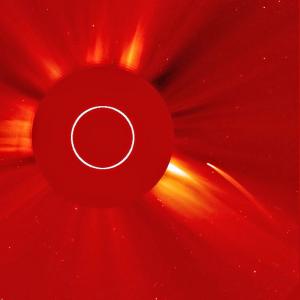Post
To Greet
the Morning Sun
18 July 2013
Comets are often pictured as cold objects, far from the Sun, but in fact there are many comets that approach quite close to the Sun, such as the one pictured below. They are known as sungrazers, and they have an interesting story to tell.
 SOHO
SOHOSungrazers typically come within a couple solar radii of the Sun, which is extraordinarily close. Comets become sungrazers over time. They start off in orbits tilted significantly to the orbital plane of the planets, and over time their orbits become increasingly elongated, and their distance of closest approach (known as their perihelion) gets ever smaller. This is due to gravitational interactions between the comet and the planets, known as the Kozai mechanism.
Such a close approach to the Sun is obviously very hard on a comet. Many of them are disintegrated during close approach, or are broken apart into smaller comets. Because of this, sungrazing comets tend to cluster in families of comets with similar orbits and a common ancestor. The largest such family is known as the Kreutz family.
Most Kreutz comets are quite small, and have only been observed by modern solar satellites such as SOHO. However some have been quite bright. Perhaps the most famous one is Ikeya-Seki in 1965, which was the brightest comet in living memory. A century earlier there were the great comets of 1843 and 1882. At their brightest both of these could be observed during the day. The great comet of 1882 was observed to fragment after its closest approach, which demonstrates how families of comets are formed.
Analysis of the orbits of Ikeya-Seki and 1882 indicate that they are likely fragments of an earlier comet seen in 1106, known as Progenitor II. The 1843 comet is likely a fragment of Progenitor I. These two larger fragments likely have a common ancestor. This grandfather of the Kreutz family was likely 100 kilometers in diameter. It has been proposed that it was observed in 371 BC by Aristotle, but other possibilities are comets appearing around 200 to 400 AD.
This fall another sungrazing comet will appear in the sky. It is not part of the Kreutz family, as its orbit is quite different. This comet, commonly known as ISON, will likely be visible with the naked eye, and could possibly become brighter than the moon. Comet brightness is notoriously difficult to predict. Its close approach to the Sun also means it will quite possibly fragment.
We’ll just have to wait for it to greet the Sun.